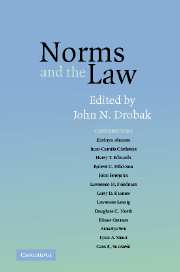Book contents
- Frontmatter
- Contents
- List of Contributors
- Acknowledgments
- Introduction
- PART ONE RATIONALITY AND NORMS
- PART TWO NORMS OF THE COMMONS
- PART THREE JUDICIAL NORMS
- 7 Judging the Judges: Some Remarks on the Way Judges Think and the Way Judges Act
- 8 Judicial Independence in a Democracy: Institutionalizing Judicial Restraint
- 9 Black Judges and Ascriptive Group Identification
- 10 Judicial Norms: A Judge's Perspective
- PART FOUR THE INFLUENCE OF LAW ON NORMS
- References
- Index
9 - Black Judges and Ascriptive Group Identification
Published online by Cambridge University Press: 05 June 2012
- Frontmatter
- Contents
- List of Contributors
- Acknowledgments
- Introduction
- PART ONE RATIONALITY AND NORMS
- PART TWO NORMS OF THE COMMONS
- PART THREE JUDICIAL NORMS
- 7 Judging the Judges: Some Remarks on the Way Judges Think and the Way Judges Act
- 8 Judicial Independence in a Democracy: Institutionalizing Judicial Restraint
- 9 Black Judges and Ascriptive Group Identification
- 10 Judicial Norms: A Judge's Perspective
- PART FOUR THE INFLUENCE OF LAW ON NORMS
- References
- Index
Summary
The literature on judicial independence has begun to be enriched by what might be described as its complement: a focus on judicial interdependence – that is, judicial connection or affiliation with identifiable groups in the larger population, members of whom will predictably appear before the courts. Judges are, as a normative matter, assumed or exhorted to be independent; yet they may also have, as a descriptive matter, connections to or affinities for different groups within their jurisdictions. Works arguing that these affinities shape the process or outcomes of adjudication date back to the legal realists; and they have recently served to challenge the norm of independence. But these works have tended to elide a set of more difficult questions: How precisely does judicial interdependence affect the operation of the judicial role? Is judicial connection with particular groups simply in tension with impartiality, or might a more interdependent judicial stance be in some ways consistent with impartiality, or help to refine our understanding of what impartiality for situated decisionmakers might mean? In order to confront these questions more directly, I propose to examine judicial interdependence in the context of one kind of affinity: ascriptive group membership, or membership in certain socially-salient groups or categories, which tends to be assigned through a series of complex social processes, on the basis of visible, largely immutable characteristics such as gender or race.
This chapter begins by considering several related literatures that highlight judicial interdependence or connection with particular groups.
- Type
- Chapter
- Information
- Norms and the Law , pp. 208 - 229Publisher: Cambridge University PressPrint publication year: 2006



